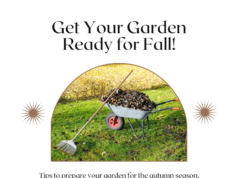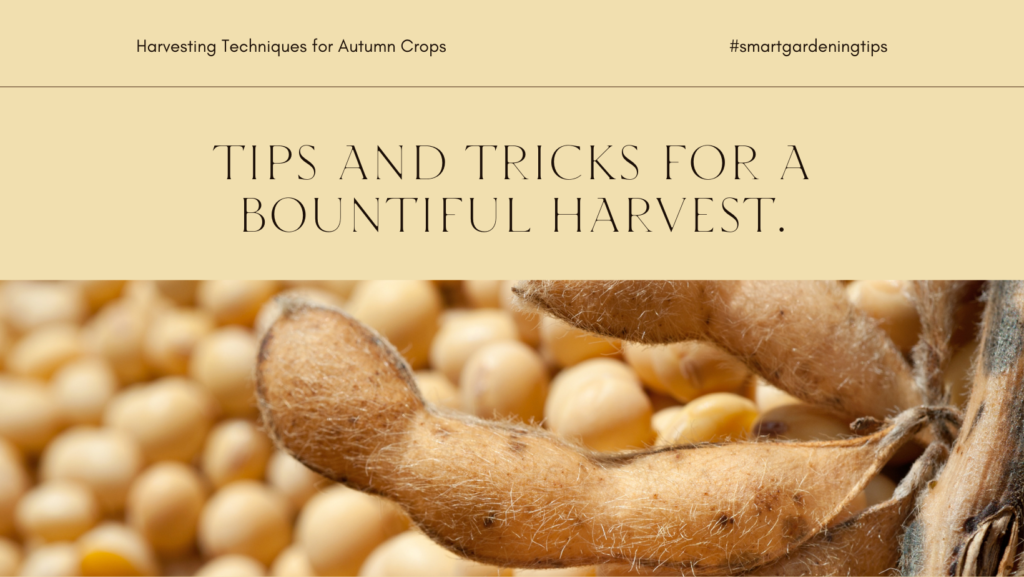
Welcome to our comprehensive guide on efficient techniques for maximizing the yield of your autumn crops. As the crisp air and vibrant colors of fall surround us, it’s the perfect time to explore specific harvesting methods for corn, apples, pumpkins, grapes, and wheat. Whether you’re a seasoned farmer or a passionate home gardener, this article will provide expert insights and tips to help you make the most of your autumn harvest.
Key Takeaways:
- Learn the best practices for harvesting corn, apples, pumpkins, grapes, and wheat.
- Discover the ideal timing and methods for each crop.
- Explore specialized machinery, equipment, and technology that can enhance your harvest.
- Understand the importance of post-harvest handling and storage.
- Implement strategies to maximize the yield and quality of your autumn crops.
Corn harvesting techniques for autumn crops
Corn is a staple autumn crop that requires careful harvesting techniques to optimize your yield and ensure the quality of your harvest. In this section, we will explore the best practices for corn harvesting, including the use of specialized machinery and equipment.
When it comes to corn harvesting techniques for autumn crops, timing is crucial. Harvesting corn at the right stage of maturity is essential for achieving optimal flavor and texture. Most corn varieties are harvested when the kernels are fully developed and still moist but not overly mature.
One common practice in corn harvesting is to observe the corn silk. When the silk turns brown and becomes dry, it is a good indicator that the corn is ready for harvest. Additionally, you can also check the kernels by piercing them with your fingernail. If the liquid is milky, it is an indication that the corn is at its peak maturity.
Using specialized machinery and equipment can significantly improve the efficiency of your corn harvesting process. Here are some essential tools and equipment to consider:
- Corn Harvesters: These machines are designed specifically for corn harvesting, allowing for efficient and precise harvesting of the ears.
- Corn Headers: Headers are attachments that can be added to combine harvesters, enabling them to effectively harvest corn crops.
- Gravity Wagons: These wagons are commonly used to transport harvested corn from the field to the storage or processing facilities.
Aside from machinery and equipment, it’s important to follow the best practices for corn harvesting to ensure a successful harvest. Here are some key tips to keep in mind:
- Harvest during dry weather conditions to prevent contamination and mold growth.
- Start harvesting from the outside rows of the field and gradually work your way towards the center.
- Adjust the harvesting speed to maintain the quality of the harvested corn, taking into account factors such as moisture level and field conditions.
- Regularly inspect and maintain your machinery and equipment to prevent breakdowns and ensure optimal performance.
By implementing these corn harvesting techniques for autumn crops and utilizing the right machinery and equipment, you can maximize your yield and produce high-quality corn harvests. Now, let’s take a closer look at the harvesting techniques for other autumn crops, such as apples, pumpkins, grapes, and wheat.
Apple harvesting techniques for autumn crops
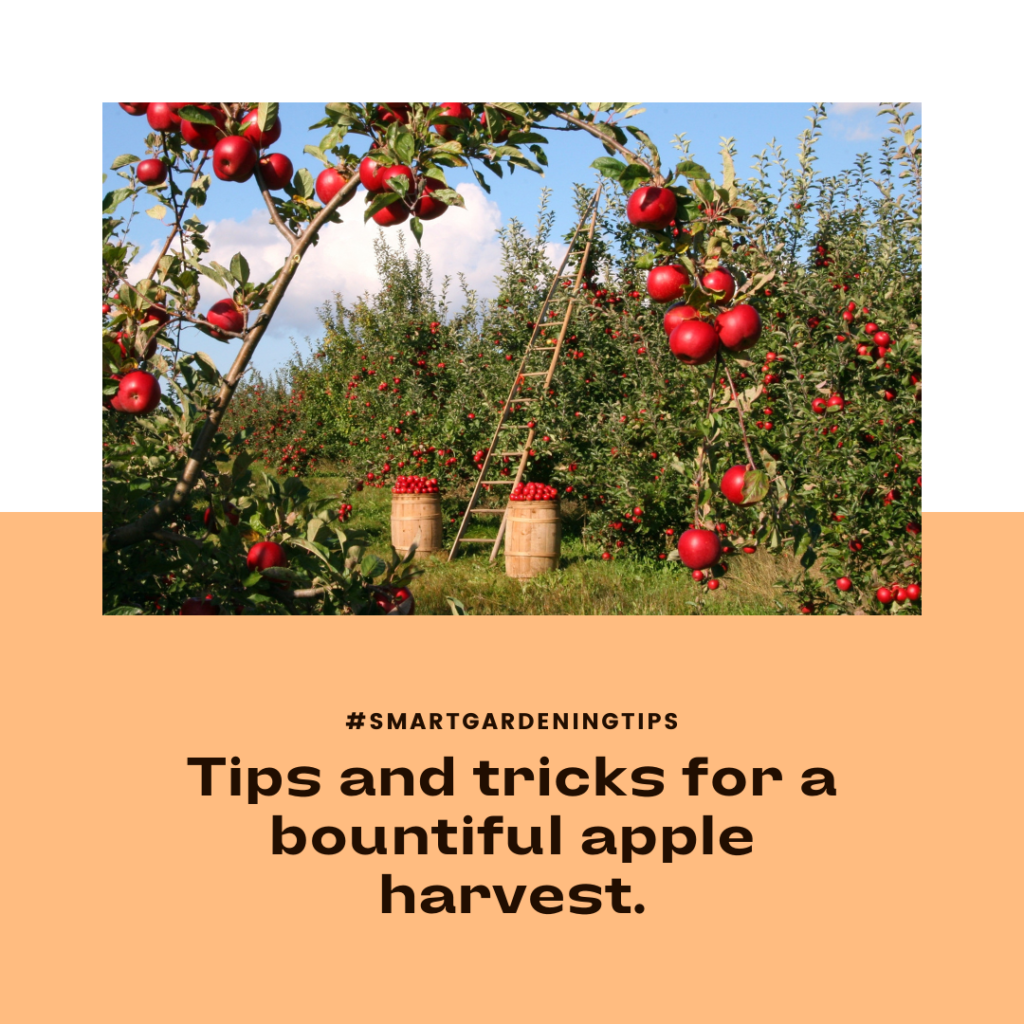
Apples are a beloved autumn crop, and to ensure the highest quality and flavor, it is crucial to employ proper harvesting techniques. In this section, we will explore the ideal timing and methods for apple harvesting, as well as the essential tools and storage solutions that will preserve their freshness throughout the season.
Timing Is Everything
When it comes to apple harvesting, timing plays a crucial role in determining the fruit’s taste and texture. It is best to wait until the apples are fully ripe before picking them. Look for signs such as firmness, bright color, and ease of separation from the tree. Generally, apples are ready to be harvested when they have reached their full size and the seeds have turned dark brown.
Harvesting Methods
There are primarily two common methods for harvesting apples: handpicking and utilizing mechanical equipment. Handpicking involves gently twisting or pulling the apple from the tree, being careful not to damage the fruit or surrounding branches. This method is preferred for delicate apple varieties and small-scale orchards.
If you have a larger apple orchard or want to streamline the process, mechanical harvesters can be a valuable tool. These machines use shaking mechanisms to loosen the apples from the tree, collecting them in bins or on conveyor belts. Mechanical harvesting can significantly increase efficiency, particularly for commercial apple farms.
Essential Tools and Storage Solutions
Having the right tools and storage solutions is essential for optimal apple harvest preservation. Here are some recommended items:
- Pruning shears or sharp garden scissors for clean and precise apple removal.
- Harvest bags or lightweight baskets to prevent bruising and minimize damage.
- Apple crates or containers with good ventilation to allow air circulation, preventing spoilage.
- Paper or foam dividers to separate layers of apples within the containers, reducing pressure and bruising.
- Refrigeration or cold storage facilities to maintain the apples’ freshness and extend their shelf life.
It is essential to handle the apples with care during harvesting and storage to minimize bruising and maintain their quality. Remember that a few bruised apples can affect the entire batch. By following proper apple harvesting techniques and utilizing the right tools and storage solutions, you can enjoy the delicious taste of freshly picked apples throughout the autumn season.
Pumpkin harvesting techniques for autumn crops
Pumpkins are a beloved symbol of autumn, and knowing the right techniques for harvesting them can lead to an abundant yield. To optimize your pumpkin harvest, it’s essential to employ effective pumpkin harvesting techniques, implement tips for maximum yield, and ensure proper post-harvest handling.
Maximizing Yield
When it comes to maximizing pumpkin yield, there are a few key considerations:
- Choose the right time: Harvest your pumpkins when they are fully mature and have reached their optimal size. This ensures that they have developed the full flavor and color.
- Handle with care: When harvesting, be gentle to avoid any damage to the pumpkin’s skin. Small cuts or punctures can lead to rot or spoilage during storage.
- Use the right tools: Invest in high-quality tools such as sharp pruning shears or knives specifically designed for pumpkin harvesting. This will make the process easier and reduce the risk of damage.
Post-Harvest Handling
Proper post-harvest handling is crucial to maintain the quality and longevity of your pumpkins:
- Clean and disinfect: After harvest, remove any dirt or debris from the pumpkins’ surface. This prevents the growth of bacteria or fungi that can cause spoilage.
- Cure the pumpkins: Allow the pumpkins to cure in a dry, well-ventilated area for about a week. This process helps harden the skin and extends their shelf life.
- Store in ideal conditions: Pumpkins should be stored in a cool, dry place with good air circulation. Avoid direct sunlight and excessive moisture, as these can accelerate decay.
To further illustrate the importance of pumpkin harvesting techniques, here’s a helpful table showcasing the recommended harvesting methods, yield tips, and post-harvest handling considerations:
| Harvesting Methods | Yield Tips | Post-Harvest Handling |
|---|---|---|
| Harvest when stem turns brown and withers. | Avoid excessive handling to prevent bruises. | Store at a temperature of 50-55°F (10-13°C). |
| Cut the stem 2-3 inches above the pumpkin. | Rotate pumpkins periodically during storage to prevent soft spots. | Avoid storing near fruits that release ethylene gas, as it can accelerate decay. |
| Harvest before the first frost. | Leave a portion of the stem intact for better longevity. | Inspect for signs of spoilage regularly and remove any affected pumpkins. |
Implementing these pumpkin harvesting techniques and following the tips for maximum yield and post-harvest handling will help you achieve a bountiful harvest of healthy and vibrant pumpkins that can be enjoyed throughout the autumn season.
Grape harvesting techniques for autumn crops
Grapes are a crucial component of autumn crops, especially for winemaking. Harvesting grapes requires careful consideration and adherence to proper techniques to ensure optimal quality and yield. In this section, we will explore the different grape harvesting methods, including handpicking and mechanical harvesting. We will also highlight the significance of using the right equipment and implementing quality control measures throughout the process.
When it comes to grape harvesting, two primary methods are commonly employed: handpicking and mechanical harvesting. Handpicking involves harvesting grapes manually, where experienced grape pickers carefully select and detach ripe clusters from the vines. This method allows for meticulous inspection, ensuring that only the best grapes are collected.
On the other hand, mechanical harvesting involves using specialized equipment to automate the grape harvesting process. Mechanical harvesters efficiently collect grapes by gently shaking the vines, allowing the ripe clusters to be mechanically detached and collected. This method is often preferred for large-scale grape harvesting, as it significantly reduces labor costs and increases efficiency.
However, the choice between handpicking and mechanical harvesting depends on various factors, including the vineyard size, grape variety, and desired quality. Handpicking allows for more selective harvesting, ensuring that only ripe and healthy grapes are collected. It is ideal for vineyards that prioritize premium wine production, where quality control is of utmost importance.
Alternatively, mechanical harvesting is advantageous for larger vineyards that prioritize efficiency and cost-effectiveness. While it may not offer the same level of precision as handpicking, advancements in technology have significantly improved mechanical harvesters’ accuracy and gentleness on the grape clusters.
Grape Harvesting Equipment
Proper grape harvesting equipment is essential to facilitate a successful harvest. Here are some commonly used tools:
- Grape harvesting shears: These specialized scissors are designed to cut grape clusters efficiently, minimizing damage to the vines and fruit. They enable faster harvesting while ensuring precision.
- Grape bins and crates: These containers are used to transport harvested grapes from the vineyard to the winery or processing area. They are designed to protect the grapes and prevent damage during transportation.
- Grape sorting table: This table allows the sorting and removal of any undesirable grapes or debris. It ensures that only high-quality grapes are further processed and contributes to the overall quality control process.
Quality Control in Grape Harvesting
Ensuring quality control during the grape harvesting process is vital to produce exceptional wines. Here are a few quality control measures to consider:
- Rigorous inspection: Whether using handpicking or mechanical harvesting, inspect the grapes for ripeness, health, and freedom from pests or diseases. Remove any damaged or unripe grapes to maintain quality.
- Temperature control: Harvest grapes during cooler periods, such as early morning or late evening, to prevent spoilage and maintain their freshness and flavor.
- Proper handling: Avoid excessive crushing or bruising of the grapes during harvesting, transportation, and processing, as this can affect the quality of the resulting wine.
In conclusion, grape harvesting techniques for autumn crops play a vital role in determining the quality and yield of the grapes, especially for winemaking. Whether you choose handpicking or mechanical harvesting, it is crucial to use the right equipment and implement quality control measures to ensure exceptional grapes and wines.
Wheat harvesting techniques for autumn crops
As you prepare to harvest your autumn wheat crops, it’s crucial to understand the right techniques that will ensure a successful harvest. With the right knowledge, you can maximize your yield and streamline the harvesting process. Let’s delve into the various stages involved in harvesting wheat, as well as the machinery and technology that can assist you in this endeavor.
The Wheat Harvesting Process and Stages
The wheat harvesting process encompasses several stages, each crucial for a bountiful yield:
- Stage 1: Preparing the field – Before harvesting, it’s essential to assess the field’s readiness. This involves monitoring the moisture content and ensuring the crop has reached optimal maturity.
- Stage 2: Cutting – Once the field is deemed suitable for harvest, cutting the wheat stalks at the base is the first step. This can be done manually, using handheld scythes, or with modern machinery.
- Stage 3: Threshing – After cutting, the next stage is threshing, where the grains are separated from the straw. Traditional methods involved using flails or animals to tread upon the harvested crop, but mechanized equipment is now widely used.
- Stage 4: Separating – In this stage, known as winnowing, the grain and chaff are separated. This is typically accomplished through air blowing or using specialized machinery.
- Stage 5: Cleaning and storage – The final stage involves cleaning the grains to remove any remaining impurities and storing them properly to maintain quality.
Wheat Harvesting Machinery and Technology
Image:
The advancements in agricultural machinery and technology have revolutionized the wheat harvesting process, enhancing efficiency and productivity. Here are some key tools and equipment used:
“The combine harvester, also known as a combine, is a vital machine in modern wheat harvesting. It integrates the cutting, threshing, and winnowing stages into a single process, significantly reducing labor and time.”
Combine harvesters come in various sizes and configurations, allowing farmers to choose the one most suitable for their field and production scale. These machines are equipped with advanced technologies like GPS monitoring and yield mapping, enabling precise crop management and data collection.
In addition to combine harvesters, other machinery commonly employed in wheat harvesting includes:
- Tractors and trailers for transporting the harvested wheat
- Grain carts for efficient grain collection in the field
- Grain handling systems for cleaning and drying the harvested wheat
- Storage bins and silos for proper grain storage and preservation
By utilizing these modern tools, farmers can optimize their wheat harvest, improve yields, and streamline the overall process.
In conclusion, mastering the wheat harvesting techniques for autumn crops is essential for maximizing your yield. Understanding the wheat harvesting process and stages, as well as utilizing the right machinery and technology, will enable you to achieve efficient and successful harvests year after year.
Maximizing yield and quality
When it comes to harvesting your autumn crops, achieving maximum yield and ensuring high-quality output are crucial for a successful harvest. In this section, we will discuss essential best practices and specific tips for corn, pumpkins, and grapes, helping you optimize your results and make the most out of your hard work.
Best practices for corn harvesting
When harvesting corn, there are several best practices that can help you achieve optimal yield and quality. Here are some key tips to consider:
- Harvest corn when the ears are fully mature and the husks have turned brown and dry.
- Use a corn harvester equipped with a corn header, which allows for efficient and precise harvesting.
- Ensure the corn harvesting equipment is properly maintained and adjusted for optimal performance.
- Regularly monitor moisture levels to ensure the ideal moisture content for storage and prevent post-harvest issues.
- Implement proper storage and drying techniques to maintain the quality of harvested corn.
Pumpkin harvesting tips for maximum yield
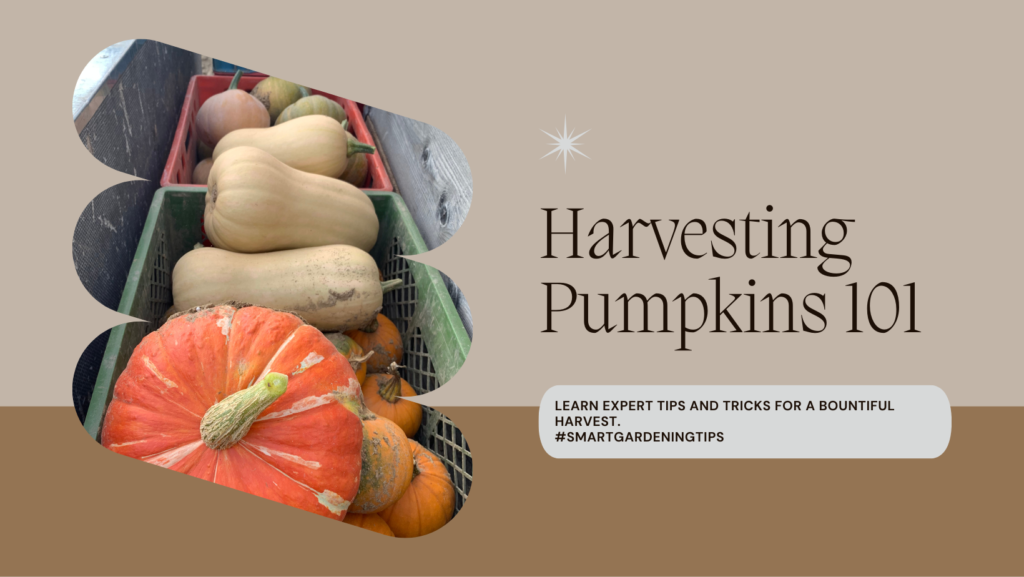
When it comes to pumpkins, following these tips can help you maximize yield and obtain top-quality pumpkins:
- Harvest pumpkins when their skin has hardened and turned the desired color, typically a deep orange or yellow.
- Use a sharp knife or pruning shears to cut the pumpkins from the vine, leaving a few inches of stem attached.
- Handle pumpkins with care to avoid any bruises or wounds that can compromise their quality and shelf life.
- Select pumpkins with a thick, firm skin and no signs of decay or damage.
- Store pumpkins in a cool, dry place with good ventilation to extend their shelf life.
Grape harvesting equipment and quality control
Grapes require careful harvesting to ensure the best flavor and quality. Consider the following tips:
The quality of grapes begins in the vineyard. It is important to select the right harvesting equipment and implement proper quality control measures to preserve the grapes’ integrity and flavor.
When harvesting grapes, you have the option of handpicking or using mechanical harvesters. Handpicking allows for selective harvesting of fully ripe grapes, while mechanical harvesting can be faster and more cost-effective. Whichever method you choose, it is crucial to use high-quality harvesting equipment to minimize damage to the grapes and maximize efficiency.
Additionally, implementing rigorous quality control measures during and after the harvest ensures that only the best grapes make it to the winemaking process. This involves carefully inspecting grapes for ripeness, disease, and any debris that may have collected during harvesting.
Here’s an example of a comprehensive table showcasing the recommended equipment and quality control practices for grape harvesting:
| Equipment | Quality Control Practices |
|---|---|
| Vineyard pruners | Inspect grapes for signs of disease or damage before harvesting. |
| Picking bins or buckets | Ensure clean and sanitized containers to prevent contamination of grapes. |
| Mechanical harvesters | Regularly check and maintain the machinery to minimize damage to grapes. |
| Grape sorting equipment | Sort grapes carefully to remove any damaged, unripe, or overripe berries. |
By following these tips and utilizing the appropriate equipment, you can harvest grapes with precision and maintain the quality required for exceptional wines.
Remember, proper harvesting techniques are key to maximizing yield and quality for your autumn crops. Implement these best practices and specific tips for corn, pumpkins, and grapes to optimize your harvest results and enjoy the fruits of your labor.
Post-harvest handling and storage
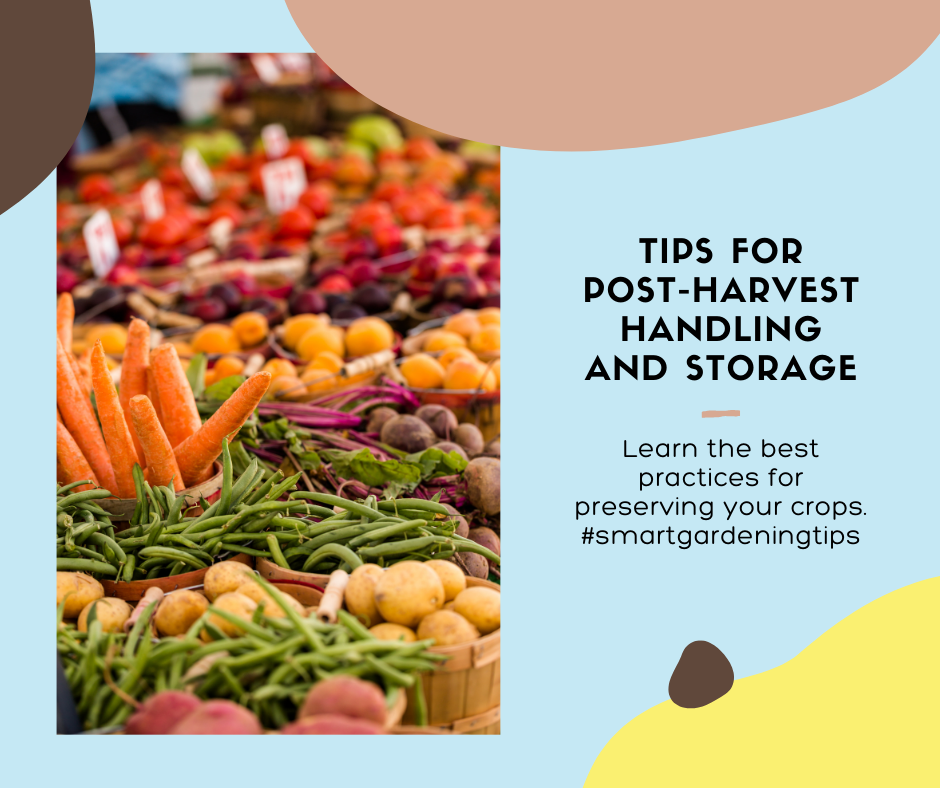
Proper post-harvest handling and storage are critical to preserve the quality and longevity of your autumn crops. Whether you’re harvesting apples or pumpkins, implementing the right tools and techniques can significantly impact the freshness and taste of your produce.
When it comes to apple harvesting, having the right tools is essential. Invest in sturdy baskets or crates to prevent bruising and damage to the fruits during harvesting and transportation. Additionally, consider using apple picking poles with soft padding to ensure a gentle harvest process.
“Invest in sturdy baskets or crates to prevent bruising and damage to the fruits during harvesting and transportation.”
Once you have harvested your apples, proper storage is key to maintain their quality. Store them in a cool, dark place with controlled humidity levels to prevent premature ripening or spoilage. Using apple storage solutions like refrigerators or cold storage facilities can help prolong their shelf life and preserve their taste.
When it comes to pumpkin harvesting, handling them with care is crucial to avoid any cuts or bruises on their delicate skin. To ensure post-harvest quality, gently cut the pumpkin from the vine, leaving a long stem intact for better storage. Avoid carrying pumpkins by their stems, as this can cause them to break off.
After harvesting pumpkins, it’s crucial to provide them with the right post-harvest care. Clean the pumpkins with a mild sanitizing solution to remove any dirt or debris. Once cleaned, allow them to dry thoroughly before storing. By following these post-harvest handling steps, you can ensure the longevity and freshness of your pumpkins.
To summarize the post-harvest handling and storage solutions for apples and pumpkins:
| Apple Harvesting Tools | Storage Solutions |
|---|---|
| Sturdy baskets or crates | Refrigerators or cold storage facilities |
| Apple picking poles with soft padding | Controlled humidity levels |
Implementing the right tools and storage solutions for apple harvesting and post-harvest handling of pumpkins can make a significant difference in the quality and freshness of your autumn crops.
Importance of timing and methods
When it comes to apple harvesting, timing and methods are crucial factors that contribute to the success of your harvest. Getting these aspects right can significantly optimize the flavor and texture of your apples, ensuring a bountiful and delicious yield.
Let’s first discuss the importance of timing. Harvesting apples too early or too late can impact their taste and ability to store well. To determine the ideal time for harvesting, consider factors such as the apple variety, weather conditions, and ripeness indicators.
[Include an image of freshly harvested apples]
When apples are ready for harvest, their color, firmness, and sugar content are key indicators. Most apple varieties can be picked when they reach their full color and can be easily separated from the tree with a gentle twist. However, some varieties may require additional maturity tests, such as starch-iodine tests or sugar/acidity measurements.
The choice of harvesting methods also plays a crucial role in maintaining the quality of your apples. Two common methods include handpicking and using mechanical harvesters. Handpicking is ideal for smaller orchards or when apples are destined for premium markets, as it allows for careful selection and minimizes damage to the fruit. On the other hand, mechanical harvesters are efficient for large-scale operations but require careful calibration to ensure minimal fruit injury.
“The right timing and methods for apple harvesting can make all the difference in the quality and marketability of your crop. By understanding the ripeness indicators and choosing the appropriate harvesting techniques, you can ensure optimal flavor and texture, resulting in apples that are a delight to consumers.”
To summarize, timing your apple harvest accurately and employing suitable methods are essential for enhancing the flavor and texture of your apples. By paying attention to ripeness indicators, considering factors like variety and weather, and choosing the appropriate harvesting techniques, you can ensure a successful apple harvest that delights both you and your customers.
| Benefits of Proper Timing and Methods for Apple Harvesting |
|---|
| Optimized Flavor |
| Harvesting apples at the right time allows them to develop their unique flavor profiles, ensuring a taste that is both sweet and tangy. |
| Enhanced Texture |
| Proper timing and gentle harvesting methods prevent bruising and maintain the desirable crispness and juiciness of the apples. |
| Improved Storage Potential |
| Timing the harvest correctly ensures apples are picked at their peak condition, maximizing their shelf life and minimizing spoilage during storage. |
Machinery and equipment for efficient harvesting
When it comes to harvesting corn, grapes, and wheat, having the right machinery and equipment can make all the difference in maximizing efficiency and productivity. By investing in advanced technology and implementing quality control measures, you can streamline your harvesting process and optimize crop yield.
Corn Harvesting Machinery and Equipment
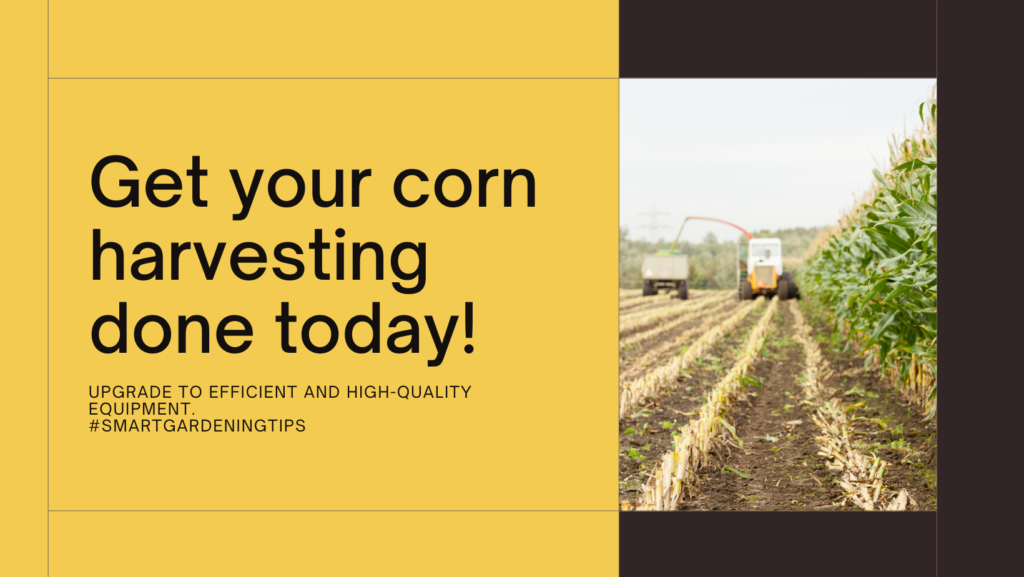
Corn, being a widely cultivated crop, requires specialized machinery and equipment for efficient harvesting. The use of modern corn harvesters, also known as combines or harvesters, can significantly increase productivity. These machines are designed to perform multiple functions, such as cutting, husking, and shelling the corn, all in one pass.
One example of a renowned corn harvester is the John Deere S700 Combine. This cutting-edge machine features advanced automation, on-the-go adjustments, and efficient grain handling capabilities. With its precise harvesting technology, it ensures minimal losses and optimal performance.
| Benefits of Modern Corn Harvesters | Advanced Features |
|---|---|
| 1. Increased harvesting speed, leading to higher productivity | 1. Automated adjustment systems for optimal performance |
| 2. Enhanced grain quality with reduced damage and loss | 2. Real-time data monitoring and analysis for improved decision-making |
| 3. Efficient corn stalk management, reducing post-harvest cleanup | 3. Precise yield monitoring and documentation for accurate record-keeping |
Grape Harvesting Equipment and Quality Control
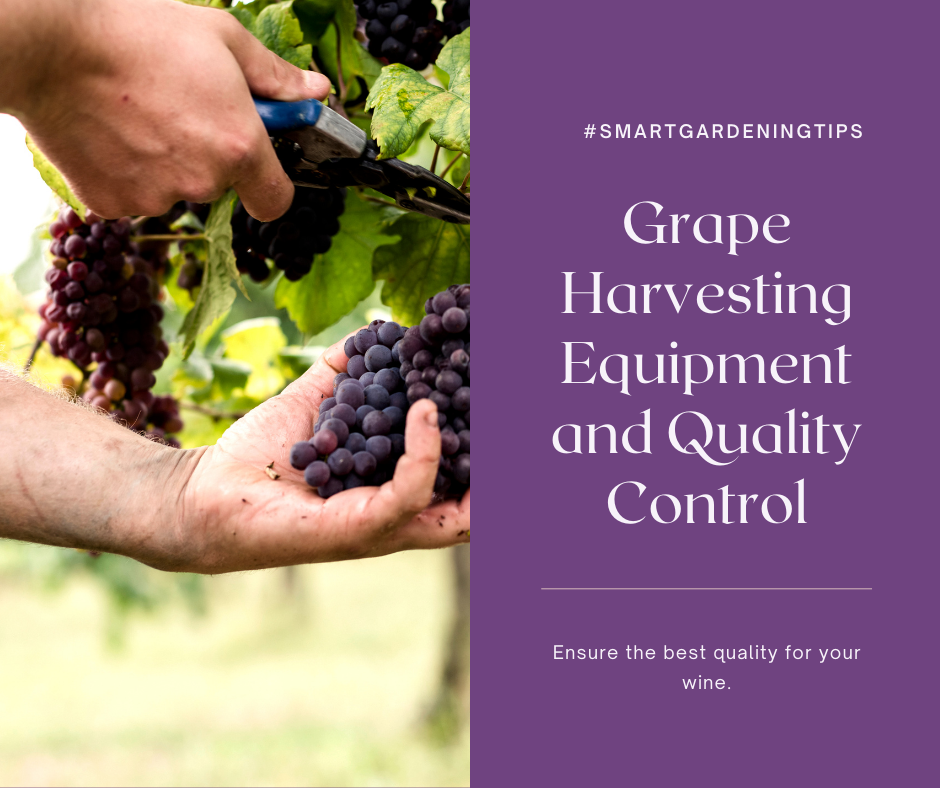
When it comes to harvesting grapes, the right equipment and stringent quality control measures are crucial to preserving the integrity of the fruit and maintaining wine-making standards. The choice between handpicking and mechanical harvesting depends on various factors, including grape variety, vineyard size, and desired quality.
Mechanical grape harvesters have become increasingly popular due to their efficiency and cost-effectiveness. These machines utilize a combination of shaking, vibration, and collection systems to gently separate the grapes from the vines. They ensure a higher harvesting speed, reduce labor costs, and minimize unwanted contaminants.
One notable grape harvester is the Pellenc 890, known for its innovative design and exceptional performance. Equipped with advanced technology, it offers gentle grape handling, selective harvesting options, and effective stems and leaf removal.
| Mechanical Harvesting vs. Handpicking | Benefits of Pellenc 890 Grape Harvester |
|---|---|
| 1. Increased harvesting speed and efficiency | 1. Gentle grape handling for optimum fruit quality |
| 2. Reduced labor costs and dependency | 2. Selective harvesting options for different grape varieties |
| 3. Minimized risk of contamination and disease spread | 3. Effective removal of stems and leaves |
Wheat Harvesting Machinery and Technology
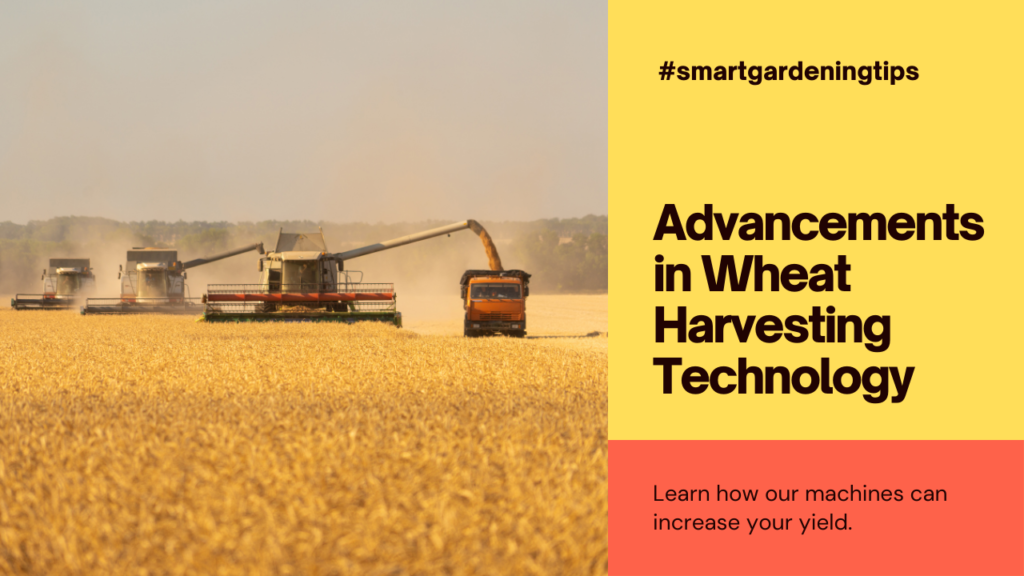
Efficient wheat harvesting involves using the right machinery and technology to optimize crop output. Combines are the primary machines used for wheat harvesting due to their versatility and ability to perform multiple tasks seamlessly.
The Case IH Axial-Flow Combine is a popular choice among wheat farmers. This combine offers superior harvesting capacity, unmatched grain quality, and advanced automation features for precise crop management. With its high-performance rotor and optimized threshing system, it ensures clean separation and minimal grain loss.
| Benefits of Case IH Axial-Flow Combine | Advanced Features |
|---|---|
| 1. High productivity and efficient throughput | 1. Real-time crop and performance monitoring |
| 2. Excellent grain quality with minimal losses | 2. Automated header control for optimal cutting performance |
| 3. Enhanced operator comfort and ease of use | 3. Integrated technology for precise yield mapping and analysis |
By utilizing cutting-edge machinery and equipment for corn, grape, and wheat harvesting, you can streamline your operations and maximize your autumn crop yield. The advanced technology, automation features, and precision of these machines ensure efficient performance, higher productivity, and improved grain quality. Additionally, implementing quality control measures further enhances the overall harvesting process, resulting in optimal outcomes and customer satisfaction.
FAQ
Q. What are some efficient techniques for maximizing the yield of autumn crops?
A. To maximize the yield of your autumn crops, it is essential to employ efficient harvesting techniques. Different crops may require specific methods and considerations. In this article, we will focus on corn, apples, pumpkins, grapes, and wheat and provide expert insights and tips to help you optimize your harvest.
Q. What are the best practices for harvesting corn in autumn?
A. When harvesting corn in autumn, it is advisable to use specialized machinery and equipment designed for this purpose. This includes corn harvesters, also known as combine harvesters, which efficiently remove the corn kernels from the stalks. By using the proper machinery, you can ensure a more productive and efficient harvest.
Q. What is the ideal timing and method for harvesting apples in autumn?
A. The ideal timing for harvesting apples in autumn depends on the variety of apple and the intended use. Generally, apples should be harvested when they are firm and fully colored. Different apple varieties have different harvest windows, so it’s essential to consult a local horticulturist or apple expert for specific recommendations. As for the method, apples are typically handpicked from the tree, taking care not to damage the fruit or the tree itself.
Q. Are there specific tools and storage solutions for harvesting and storing apples?
A. Yes, there are specific tools and storage solutions that can help facilitate the apple harvesting and storage process. These tools include picking buckets or bags, orchard ladders, and pruning shears. When it comes to storage, apples should be kept in cool, humid conditions to maintain their freshness. Options for apple storage include refrigeration, cold storage facilities, and controlled atmosphere storage, which can extend the shelf life of the fruit.
Q. What are some tips for maximizing the yield of pumpkin harvest?
A. To maximize the yield of your pumpkin harvest, consider the following tips: 1) Plant pumpkins in well-drained soil with good fertility, 2) Provide adequate water and nutrients throughout the growing season, 3) Regularly monitor for pests and diseases, and take appropriate action if necessary, 4) Harvest pumpkins when their skin is fully colored and the stem is dry and sturdy, 5) Handle pumpkins with care to avoid bruising or damage during harvesting, as this can lead to premature decay.
Q. What should be done with pumpkins after harvesting?
A. After harvesting pumpkins, it is crucial to handle them properly to ensure their longevity. Remove any dirt or debris from the surface, and store them in a cool, dry place with good ventilation. Avoid stacking pumpkins on top of each other as this can lead to bruising and decay. Regularly inspect the pumpkins for any signs of rot or spoilage, and if necessary, use them as soon as possible or preserve them through canning or freezing techniques.
Q. Is handpicking or mechanical harvesting preferable for grapes in autumn?
A. The choice between handpicking and mechanical harvesting for grapes in autumn depends on several factors. Handpicking allows for selective harvesting and reduces the risk of damage to the grapes. It is often preferred for high-quality wine production. However, mechanical harvesting can be more efficient, especially for large vineyards. It is essential to consider factors such as grape variety, vineyard size, terrain, and the intended use of the grapes when deciding on the harvesting method.
Q. What equipment is needed for grape harvesting and quality control?
A. Equipment required for grape harvesting and quality control includes grape harvesting machines, grape crushers, destemmers, and grape sorting equipment. These tools aid in efficient picking, crushing, and removing stems from the grapes, as well as sorting them based on quality standards. Quality control measures also involve the use of refractometers and pH meters to assess sugar levels and acidity, ensuring the grapes are harvested at optimal ripeness.
Q. What are the various stages and machinery involved in wheat harvesting?
A. Wheat harvesting consists of several stages, including cutting, threshing, separating, and cleaning. To carry out these tasks efficiently, specialized machinery is used. The key equipment includes combine harvesters, which can cut and thresh the wheat in one operation. These machines have cutting platforms, reel systems, threshing mechanisms, and sieves, which ensure clean and separated grain ready for storage or further processing.
Q. How can one maximize the yield and quality of autumn crops?
A. To maximize the yield and quality of autumn crops, adhere to overarching best practices and specific tips for each crop. For corn, use the proper machinery and equipment, and ensure proper planting density. For pumpkins, provide adequate water and nutrients and implement pest and disease management. For grapes, maintain vineyard health, monitor sugar levels, and carry out selective harvesting. And for wheat, time the harvest correctly, use appropriate machinery, and ensure proper storage and cleaning of grains.
Q. How should autumn crops be handled and stored after harvest?
A. Proper post-harvest handling and storage are crucial for maintaining the quality and longevity of autumn crops. After harvest, remove any damaged or diseased crops, clean them thoroughly, and store in appropriate conditions. Crop-specific measures may include refrigeration, cool storage facilities, drying, or controlled atmosphere storage. Regular monitoring of stored crops for signs of spoilage or decay is essential to address any issues promptly.
Q. Why is timing and method important in apple harvesting?
A. Timing and method are crucial in apple harvesting to optimize the flavor and texture of the fruit. Harvesting too early can result in under-ripe apples, while leaving them on the tree for too long can cause over-ripeness and loss of desired qualities. The method of handpicking ensures careful handling to avoid bruising or damage, which can impact the overall quality of the harvested apples.
Q. What machinery and technology are available for efficient wheat harvesting?
A. The machinery and technology available for efficient wheat harvesting include combine harvesters equipped with advanced features like GPS guidance, yield monitoring systems, and automatic grain adjustment. These technologies aid in precise harvesting and help optimize the efficiency and accuracy of the entire process. They also enable farmers to monitor crop conditions and make informed decisions regarding yield potential and harvest management.
Conclusion
Effective harvesting techniques are crucial for maximizing the yield of your autumn crops. Whether you’re growing corn, apples, pumpkins, grapes, or wheat, understanding the specific methods and considerations for each crop is essential.
By implementing the expert tips and insights provided in this article, you can ensure a successful autumn harvest. Remember to follow the best practices for harvesting corn, including the use of specialized machinery and equipment. And when it comes to apples, timing and proper harvesting methods are key to preserving their quality.
For pumpkins, knowing the right techniques for maximizing yield and post-harvest handling will result in abundant and flavorful harvests. When it comes to grapes, carefully consider the choice between handpicking and mechanical harvesting and invest in the necessary equipment for quality control.
Lastly, for wheat, understanding the process and stages involved in harvesting, along with the use of advanced machinery and technology, will help streamline your harvest and ensure optimal results. By applying these effective harvesting techniques to your autumn crops, you’ll reap the rewards of a bountiful and successful harvest.





